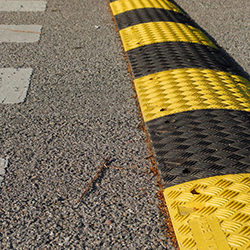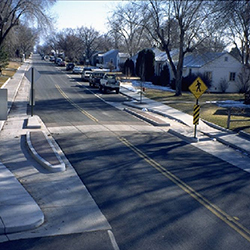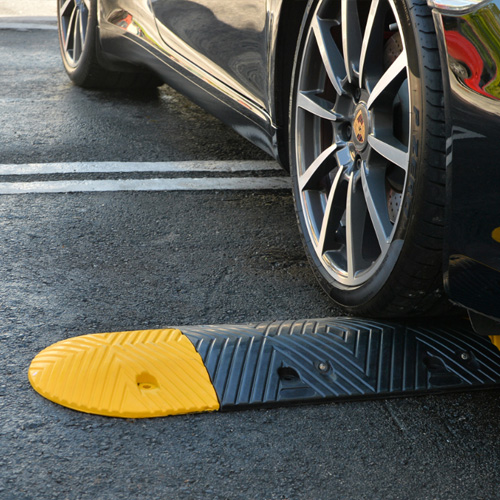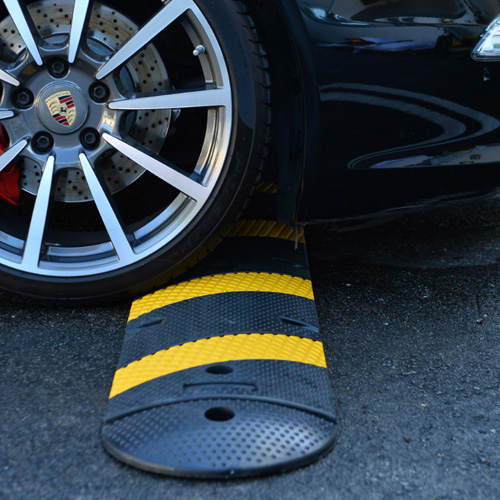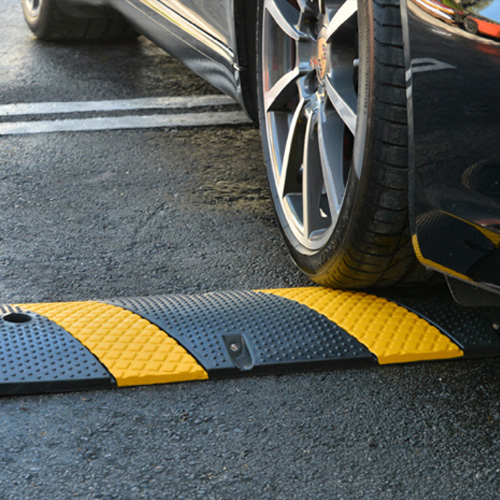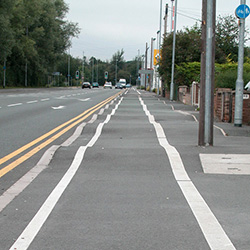Category Archives: Speed Bumps
The Versatility of EPDM Rubber Speed Bumps
What is EPDM Rubber Speed Bump?
EPDM Rubber Speed Bump is a type of traffic calming device that is made from EPDM rubber, a durable and flexible material. It is designed to slow down vehicles and improve safety in areas with high pedestrian traffic or speed limit restrictions. EPDM Rubber Speed Bumps are commonly used in parking lots, residential areas, school zones, and industrial facilities. They are available in various sizes and shapes to accommodate different traffic conditions. The advantages of EPDM Rubber Speed Bumps include their durability, resistance to weather and chemicals, easy installation, and low maintenance requirements. These speed bumps are an effective solution for controlling traffic speed and enhancing safety on the roads. Continue reading “The Versatility of EPDM Rubber Speed Bumps” »Understanding the Relationship between Speed and Accident Severity
Speed is a critical factor in determining the severity of accidents. Understanding the relationship between speed and accident severity is crucial for developing effective road safety measures. Excessive speed is a major cause of accidents and can result in more severe injuries and fatalities. This article aims to explore the various factors that affect speed and accident severity, including speed limits, driver behavior, and technological advances. By gaining a deeper understanding of these factors, we can work towards reducing the number and severity of accidents on our roads.
Continue reading “Understanding the Relationship between Speed and Accident Severity” »
Unraveling the Mysteries of Speed Bumps: A Comprehensive Guide
Understanding the Speed Bump Ahead Sign
When you encounter a speed bump ahead sign, it’s not merely a cautionary symbol; it’s a crucial prompt for every driver to adjust their speed accordingly. In traffic regulatory language, this sign indicates an upcoming area where speed bumps are deployed. These bumps are strategically placed on roadways to ensure motorists adhere to reduced speed limits for safety and road preservation.Why Do We Have Speed Bumps?
Speed bumps play a pivotal role in enhancing road safety. They are specifically designed to control and manage vehicle speeds in certain areas where maintaining a slower pace is imperative. These areas might include school zones, residential neighborhoods, or other places where pedestrian safety is a top priority.Decoding Speed Bumps in Slang
In the urban dictionary of everyday language, the term speed bumps has found its way into slang. In this context, it often refers to obstacles or challenges encountered in various aspects of life. For example, when someone says, “I faced a few speed bumps in my project,” they are alluding to unexpected difficulties or setbacks. It’s a metaphorical usage that has evolved from the physical road impediments we encounter daily.Distinguishing Between Speed Humps and Speed Bumps
While the terms speed humps and speed bumps are often used interchangeably, there’s a subtle difference between the two. A speed bump is typically shorter and more abrupt, aiming to force drivers to significantly reduce speed. On the other hand, a speed hump is longer and less severe, designed to encourage a smoother slowing down rather than a sudden jolt.The Engineering Behind Speed Bumps
Speed bumps are engineered with precision to serve their purpose effectively. They are usually made of durable materials like asphalt or rubber and are strategically installed to maintain optimal safety without causing damage to vehicles. The science behind their design ensures that drivers slow down gradually, preventing abrupt stops that could lead to accidents or vehicular damage.Navigating Speed Bumps: The Correct Driving Approach
Understanding the correct way to drive over speed bumps is essential for both the safety of your vehicle and the well-being of passengers. When approaching a speed bump, reduce your speed well in advance. This gradual slowing down allows for a smoother transition over the bump, minimizing the impact on your vehicle’s suspension and ensuring a comfortable ride for all occupants.Tips for Driving Over Speed Bumps:
- Reduce Speed Gradually: Begin slowing down well before reaching the speed bump to avoid sudden stops.
- Maintain a Straight Line: Drive over the speed bump in a straight line to prevent swaying or tilting.
- Mind Your Vehicle’s Clearance: Be mindful of your vehicle’s ground clearance, especially if it’s a low-profile car.
Conclusion
In conclusion, the speed bump ahead sign is not just a visual element on the road; it’s a crucial indicator of a forthcoming change in road conditions. Understanding the nuances of speed bumps and speed humps is essential for every driver, ensuring not only road safety but also a smooth driving experience.The Impact of Speed on Accident Risk
Introduction
Speed is a significant factor in the occurrence and severity of accidents. It is essential to understand the impact of speed on accident risk to develop effective measures for preventing and reducing accidents. This article explores the various factors that affect speed, provides statistics on accidents caused by speed, and discusses the effects of speed on accident risk. Continue reading “The Impact of Speed on Accident Risk” »Speed Bumps Manufacturers and Suppliers in the USA
Overview of Unimat Industries
Unimat Industries is a leading manufacturer and supplier in USA of high-quality traffic safety products, including speed bumps, parking stops, and traffic cones. With over 30 years of experience in the industry, Unimat Industries has established a reputation for producing durable and reliable products that meet the needs of customers in a variety of settings. The company’s speed bumps, in particular, are designed to withstand extreme weather conditions, making them ideal for use in areas with harsh climates. Unimat Industries is committed to providing innovative solutions that enhance safety and improve traffic flow, and their products are trusted by customers around the world. Continue reading “Speed Bumps Manufacturers and Suppliers in the USA” »The Environmental Benefits of Using Recycled Heavy Duty Speed Bumps
Introduction
Explanation of recycled heavy duty speed bumps
Recycled heavy duty speed bumps are made from materials that have been previously used and then processed to create a new product. These speed bumps are typically made from recycled rubber, which is a durable and long-lasting material that can withstand heavy traffic and extreme weather conditions. By using recycled materials to create speed bumps, we are reducing the amount of waste that ends up in landfills and conserving natural resources. Additionally, recycled heavy duty speed bumps are a cost-effective solution for traffic calming measures, as they require less maintenance and have a longer lifespan than traditional speed bumps. Overall, the use of recycled heavy duty speed bumps is a sustainable and environmentally friendly choice for traffic management.Importance of environmental benefits
The importance of environmental benefits cannot be overstated when it comes to using recycled heavy duty speed bumps. By using recycled materials, we are reducing the amount of waste that ends up in landfills and decreasing the need for new resources to be extracted from the earth. Additionally, the production of recycled materials requires less energy and emits fewer greenhouse gases than the production of new materials. By choosing to use recycled heavy duty speed bumps, we are making a positive impact on the environment and helping to create a more sustainable future.Reduced Carbon Footprint
Less energy required for production
Less energy required for production: One of the most significant environmental benefits of using recycled heavy-duty speed bumps is the reduced energy required for their production. The manufacturing process of traditional speed bumps involves the extraction of raw materials, transportation, and processing, which consumes a considerable amount of energy. However, recycled speed bumps are made from materials that have already been used and discarded, reducing the need for new raw materials. This results in a significant reduction in energy consumption during the production process, which translates into lower greenhouse gas emissions and a smaller carbon footprint. Additionally, the use of recycled materials reduces the amount of waste that ends up in landfills, contributing to a more sustainable and eco-friendly environment.Reduced transportation emissions
Reduced transportation emissions are one of the most significant environmental benefits of using recycled heavy-duty speed bumps. These speed bumps are made from recycled materials, which means that they do not require new resources to be extracted from the earth. This reduces the carbon footprint associated with the production of new materials. Additionally, the use of speed bumps helps to slow down traffic, which reduces the amount of fuel that vehicles burn and, in turn, reduces the amount of emissions that are released into the atmosphere. By using recycled heavy-duty speed bumps, we can help to reduce our impact on the environment and create a more sustainable future.Decreased need for raw materials
One of the most significant environmental benefits of using recycled heavy-duty speed bumps is the decreased need for raw materials. By using recycled materials, we can reduce the demand for new resources and minimize the environmental impact of extracting and processing raw materials. This, in turn, helps to conserve natural resources and reduce greenhouse gas emissions associated with the production of new materials. Additionally, recycling heavy-duty speed bumps can help to divert waste from landfills, which can reduce the amount of methane gas produced by decomposing waste. Overall, using recycled heavy-duty speed bumps is a sustainable and eco-friendly solution that can help to protect our planet for future generations.Improved Waste Management
Less waste in landfills
Less waste in landfills: One of the most significant environmental benefits of using recycled heavy-duty speed bumps is that it reduces the amount of waste that ends up in landfills. Traditional speed bumps are made of materials that are not biodegradable and cannot be recycled. This means that when they reach the end of their lifespan, they are discarded and left to take up space in landfills. However, recycled speed bumps are made from materials that have already been used and would have otherwise been thrown away. By using recycled materials, we can reduce the amount of waste that ends up in landfills and help to preserve our environment. Additionally, the production of new materials for speed bumps requires energy and resources, which can also be conserved by using recycled materials.Reduced need for new materials
One of the most significant environmental benefits of using recycled heavy-duty speed bumps is the reduced need for new materials. By using recycled materials, we can reduce the amount of waste that ends up in landfills and reduce the demand for new resources. This, in turn, reduces the environmental impact of manufacturing new materials, which often involves the extraction of raw materials and the use of energy-intensive processes. Additionally, using recycled materials can help to reduce greenhouse gas emissions, as the production of new materials is a significant contributor to carbon emissions. By using recycled heavy-duty speed bumps, we can help to reduce our environmental footprint and move towards a more sustainable future.Decreased pollution from waste disposal
Decreased pollution from waste disposal is one of the most significant environmental benefits of using recycled heavy-duty speed bumps. Traditional speed bumps are made of materials like concrete or asphalt, which are not biodegradable and can take hundreds of years to decompose. When these speed bumps reach the end of their lifespan, they are often disposed of in landfills, where they can release harmful chemicals and greenhouse gases into the environment. In contrast, recycled speed bumps are made from materials like rubber, which can be recycled multiple times and do not release harmful chemicals when disposed of. By using recycled speed bumps, we can reduce the amount of waste that ends up in landfills and decrease the pollution that results from waste disposal.Increased Durability
Longer lifespan
One of the most important environmental benefits of using Unimat Traffic heavy-duty recycled speed humps is their longer service life. Unlike traditional speed humps made of concrete or asphalt, recycled speed humps are made of durable materials that can withstand harsh weather conditions and heavy traffic. This means they require less frequent replacement, which reduces the amount of waste generated by the disposal of old speed humps. In addition, the production of new speed humps requires the extraction of raw materials, which can have a significant impact on the environment. By using recycled materials, we can reduce the demand for new resources and minimize the environmental impact of speed bump production.Less frequent replacement
One of the most significant environmental benefits of using recycled heavy-duty speed bumps is that they require less frequent replacement. Unlike traditional speed bumps made of concrete or asphalt, recycled speed bumps are made of durable materials that can withstand heavy traffic and extreme weather conditions. This means that they last longer and do not need to be replaced as often, reducing the amount of waste generated from the disposal of old speed bumps. Additionally, the production of new speed bumps requires the use of natural resources and energy, which can be conserved by using recycled materials instead. By choosing recycled heavy-duty speed bumps, we can reduce our environmental impact and promote sustainable practices.Reduced need for new materials
One of the most significant environmental benefits of using recycled heavy-duty speed bumps is the reduced need for new materials. By using recycled materials, we can reduce the demand for new resources, which in turn reduces the environmental impact of manufacturing new products. This means that fewer natural resources are extracted, and less energy is used in the production process. Additionally, recycling reduces the amount of waste that ends up in landfills, which helps to conserve valuable landfill space and reduce greenhouse gas emissions. By choosing recycled heavy-duty speed bumps, we can help to protect the environment and promote sustainable practices.Conclusion
Summary of environmental benefits
In summary, the use of recycled heavy duty speed bumps offers numerous environmental benefits. By using recycled materials, we reduce the amount of waste that ends up in landfills and decrease the need for new resources to be extracted and processed. Additionally, the installation of speed bumps can help to reduce vehicle speeds, which in turn reduces air pollution and noise pollution. Furthermore, the durability of heavy duty speed bumps means that they require less frequent replacement, reducing the overall environmental impact of their production and transportation. Overall, the use of recycled heavy duty speed bumps is a simple yet effective way to promote sustainability and reduce our impact on the environment.Encouragement to use recycled heavy duty speed bumps
Encouraging the use of recycled heavy duty speed bumps not only benefits the environment but also promotes sustainability. By using recycled materials, we reduce the amount of waste that ends up in landfills and conserve natural resources. Additionally, these speed bumps are durable and long-lasting, reducing the need for frequent replacements and ultimately saving money. Choosing to use recycled heavy duty speed bumps is a simple yet effective way to make a positive impact on the environment while also improving safety on roads and in parking lots.Heavy Duty Speed Bumps vs. Traditional Speed Bumps: Which is Better?
Introduction
Explanation of the importance of speed bumps
Speed bumps are an essential traffic calming measure that helps to reduce the speed of vehicles on roads and in parking lots. They are particularly important in areas where there are high volumes of pedestrian traffic, such as schools, hospitals, and residential areas. Speed bumps are also useful in reducing the number of accidents caused by speeding vehicles, which can result in serious injuries or fatalities. Additionally, speed bumps can help to reduce noise pollution and improve the overall safety of the community. Therefore, it is crucial to choose the right type of speed bump that is effective in slowing down vehicles while also being durable and long-lasting.Overview of the article
In this article, we will be discussing the differences between heavy-duty speed bumps and traditional speed bumps. We will explore the advantages and disadvantages of each type of speed bump, as well as the situations in which they are most effective. By the end of this article, you will have a better understanding of which type of speed bump is best suited for your specific needs. Whether you are looking to slow down traffic in a residential area or control the speed of vehicles in a commercial parking lot, this article will provide you with the information you need to make an informed decision.What are Heavy Duty Speed Bumps?
Definition of heavy duty speed bumps
Heavy-duty speed humps are designed to withstand heavy traffic and larger vehicles, such as trucks and buses. They are typically made of durable materials such as rubber or concrete and have a higher profile than traditional speed humps. Heavy-duty speed bumps are often used in industrial areas, parking lots and other high-traffic areas where vehicles move at higher speeds. They are designed to slow vehicles and reduce the risk of accidents, making them an effective traffic calming measure. Compared to traditional speed humps, Unimat Traffic heavy-duty speed humps are more durable and can withstand more wear and tear over time.Materials used in heavy duty speed bumps
Heavy duty speed bumps are designed to withstand heavy traffic and extreme weather conditions. As a result, they are made from durable materials such as rubber, plastic, or concrete. Rubber speed bumps are the most popular choice due to their ability to absorb impact and reduce noise. They are also resistant to oil, chemicals, and UV rays, making them ideal for outdoor use. Plastic speed bumps are lightweight and easy to install, but they may not be as durable as rubber or concrete. Concrete speed bumps are the most durable option, but they are also the most expensive and difficult to install. Overall, the choice of material for heavy duty speed bumps depends on the specific needs of the location and the amount of traffic it receives.Advantages of heavy duty speed bumps
Heavy duty speed bumps have several advantages over traditional speed bumps. Firstly, they are more durable and can withstand heavy traffic and harsh weather conditions. This means that they require less maintenance and replacement, resulting in cost savings in the long run. Secondly, heavy duty speed bumps are more effective in slowing down vehicles, as they are higher and wider than traditional speed bumps. This reduces the risk of accidents and improves safety for pedestrians and drivers alike. Lastly, heavy duty speed bumps are more visible, thanks to their bright colors and reflective markings. This makes them easier to spot, even in low light conditions, and helps to prevent accidents. Overall, heavy duty speed bumps are a better choice for areas with high traffic volume and heavy vehicles.What are Traditional Speed Bumps?
Definition of traditional speed bumps
Traditional speed bumps are the most common type of traffic calming measure used to slow down vehicles in areas with high pedestrian traffic. They are typically made of asphalt or concrete and are designed to be between 3 and 4 inches high. Traditional speed bumps are usually 12 to 14 feet long and are placed perpendicular to the direction of traffic. They are effective in slowing down vehicles, but they can also cause discomfort to drivers and passengers, as well as damage to vehicles if they are driven over too quickly.Materials used in traditional speed bumps
Traditional speed bumps are typically made from asphalt or concrete and are designed to slow down vehicles by creating a raised surface on the road. These materials are durable and can withstand heavy traffic, but they can also be expensive to install and maintain. Additionally, traditional speed bumps can be difficult to remove or adjust if they need to be relocated or modified. Some communities have also expressed concerns about the environmental impact of using concrete or asphalt, as these materials can contribute to urban heat islands and increase runoff. As a result, many municipalities are exploring alternative materials for speed bumps, including recycled rubber and plastic.Advantages of traditional speed bumps
Advantages of traditional speed bumps include their affordability and ease of installation. Traditional speed bumps are made of materials such as asphalt or concrete and can be easily installed by a paving contractor. They are also relatively inexpensive compared to heavy-duty speed bumps, making them a popular choice for municipalities and businesses on a budget. Additionally, traditional speed bumps are effective at slowing down traffic and reducing speeds in areas where pedestrian safety is a concern.Comparison of Heavy Duty Speed Bumps and Traditional Speed Bumps
Effectiveness in slowing down vehicles
When it comes to slowing down vehicles, both heavy duty speed bumps and traditional speed bumps are effective. However, heavy duty speed bumps are designed to slow down vehicles at a much slower speed than traditional speed bumps. This is because heavy duty speed bumps are larger and have a steeper incline, which forces drivers to slow down significantly. Traditional speed bumps, on the other hand, are smaller and have a gentler incline, which allows drivers to maintain a slightly higher speed. Ultimately, the effectiveness of either type of speed bump depends on the specific needs of the area in which they are installed.Durability and maintenance
When it comes to durability and maintenance, heavy-duty speed bumps are the clear winner. Made from high-quality materials such as recycled rubber or plastic, these speed bumps are designed to withstand heavy traffic and harsh weather conditions. They require minimal maintenance and can last for years without needing to be replaced. On the other hand, traditional speed bumps made from asphalt or concrete can crack and deteriorate over time, requiring frequent repairs and replacements. This not only adds to the cost but also causes inconvenience to drivers and pedestrians. Therefore, if you’re looking for a long-lasting and low-maintenance solution, heavy-duty speed bumps are the way to go.Cost comparison
When it comes to cost, heavy-duty speed bumps are generally more expensive than traditional speed bumps. This is because heavy-duty speed bumps are made of more durable materials, such as rubber or concrete, which can withstand heavier traffic and last longer. However, the initial investment in heavy-duty speed bumps can pay off in the long run, as they require less maintenance and replacement over time. Traditional speed bumps, on the other hand, may be more affordable upfront, but they may need to be replaced more frequently due to wear and tear. Ultimately, the decision between heavy-duty and traditional speed bumps will depend on the specific needs and budget of each individual project.Environmental impact
Environmental impact: When it comes to the environmental impact, heavy-duty speed bumps are a better option than traditional speed bumps. Heavy-duty speed bumps are made of recycled rubber, which means they are eco-friendly and do not harm the environment. On the other hand, traditional speed bumps are made of asphalt or concrete, which are not eco-friendly and can harm the environment. Moreover, heavy-duty speed bumps are designed to last longer than traditional speed bumps, which means they do not need to be replaced as often, reducing waste and saving resources. Therefore, if you are looking for a speed bump that is environmentally friendly, durable, and long-lasting, heavy-duty speed bumps are the way to go.Which is Better?
Factors to consider when choosing between heavy duty and traditional speed bumps
When deciding between heavy duty and traditional speed bumps, there are several factors to consider. Firstly, heavy duty speed bumps are typically more durable and can withstand heavier traffic volumes and larger vehicles. They are also often more visible due to their larger size and bright colors. However, traditional speed bumps are often more cost-effective and can be easier to install and maintain. Additionally, they may be more appropriate for areas with lower traffic volumes or where speed reduction is not a top priority. Ultimately, the decision between heavy duty and traditional speed bumps will depend on the specific needs and circumstances of each location.Conclusion
In conclusion, the choice between heavy duty speed bumps and traditional speed bumps ultimately depends on the specific needs and circumstances of the location. Heavy duty speed bumps are ideal for high traffic areas where heavy vehicles are present, while traditional speed bumps are suitable for low traffic areas with lighter vehicles. It is important to consider factors such as speed limit, traffic volume, and vehicle types before deciding which type of speed bump to install. Ultimately, the goal is to ensure the safety of drivers, pedestrians, and property, and both types of speed bumps can effectively serve this purpose when used appropriately.Slow Down! / How Road Narrowing Can Alter Driver Behavior and Traffic Flow
Traffic calming measures are essential for enhancing street safety and reducing the risk of accidents. These strategies aim to manage speed and create a safer environment for all road users. In this article, we will explore five effective strategies for calming traffic and improving street safety in urban areas.
Continue reading “Slow Down! / How Road Narrowing Can Alter Driver Behavior and Traffic Flow” »

